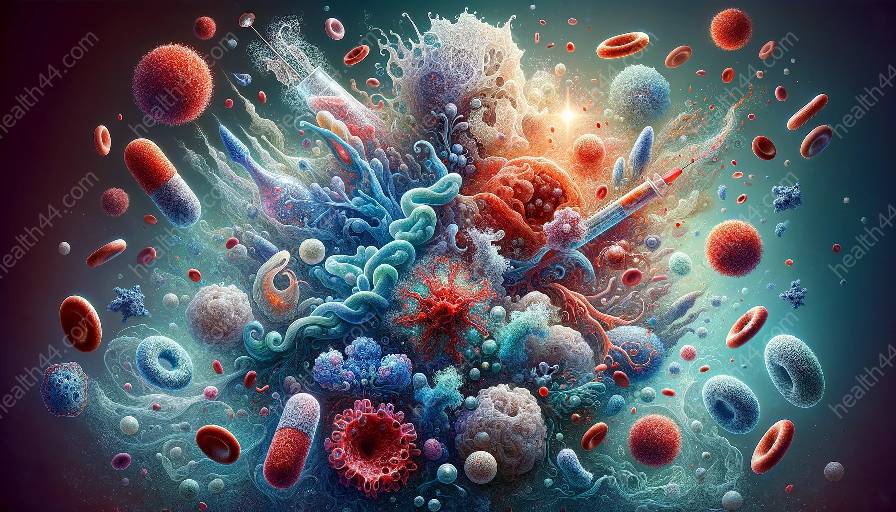Adaptive immunity is a crucial aspect of the body's defense system, providing long-term protection against specific pathogens. It involves a complex network of cells and molecules that work together to recognize and eliminate harmful invaders. This topic cluster will delve into the fundamentals of adaptive immunity, including its key components, such as T cells, B cells, and antibodies, and how it plays a vital role in immunology.
The Basics of Adaptive Immunity
Adaptive immunity, also known as acquired immunity, is an advanced and specific defense mechanism that develops in response to exposure to pathogens. Unlike innate immunity, which provides immediate but non-specific protection, adaptive immunity targets particular antigens associated with specific pathogens. This specificity enables the immune system to remember and respond more effectively upon subsequent encounters with the same pathogen.
Adaptive immunity is characterized by the presence of immune cells called lymphocytes, which include T cells and B cells. These cells undergo a process of maturation and activation to recognize and eliminate specific antigens, leading to the establishment of immunological memory.
The Key Components of Adaptive Immunity
1. T Cells: T cells, also known as T lymphocytes, play a central role in cell-mediated immunity. These cells originate from the bone marrow and mature in the thymus. Once activated, T cells can directly destroy infected cells or help other immune cells by releasing cytokines. There are several types of T cells, including helper T cells, cytotoxic T cells, and regulatory T cells, each with distinct functions in coordinating immune responses.
2. B Cells: B cells, or B lymphocytes, are responsible for producing antibodies and mediating humoral immunity. B cells mature in the bone marrow and, upon encountering specific antigens, differentiate into plasma cells that secrete antibodies tailored to the encountered antigens. Antibodies, also known as immunoglobulins, play a crucial role in neutralizing pathogens, marking them for destruction, and enhancing the overall immune response.
3. Antibodies: Antibodies are Y-shaped proteins that recognize and bind to specific antigens, facilitating their elimination from the body. They can block the ability of pathogens to infect host cells, promote the phagocytosis of pathogens by immune cells, and activate other components of the immune system. Additionally, antibodies contribute to the formation of immunological memory, providing rapid and enhanced protection upon re-exposure to the same pathogen.
The Process of Adaptive Immunity
The process of adaptive immunity begins with the recognition of antigens by T cells and B cells, leading to their activation and the initiation of specific immune responses. This recognition is facilitated by the interaction between antigens and specialized receptors on the surface of these immune cells.
Once activated, T cells and B cells undergo clonal expansion, resulting in the generation of specific effector cells that carry out immune functions, such as killing infected cells, producing antibodies, and coordinating immune responses. Following the clearance of the pathogen, a subset of these cells differentiate into long-lived memory cells, providing prolonged immunity to future encounters with the same pathogen.
Role of Adaptive Immunity in Health and Disease
Adaptive immunity plays a crucial role in protecting the body against infections and diseases. A robust and properly functioning adaptive immune system can efficiently recognize and eliminate a wide range of pathogens, including bacteria, viruses, fungi, and parasites. Additionally, adaptive immunity is essential for the success of vaccination, as it allows the generation of immunological memory without causing severe disease.
However, dysregulation of adaptive immunity can contribute to the development of autoimmune disorders, allergies, and immunodeficiency diseases. Autoimmune disorders result from an overactive immune response against self-antigens, leading to tissue damage, while allergies involve hypersensitivity reactions to harmless antigens. Immunodeficiency diseases, on the other hand, arise from impaired adaptive immunity, rendering individuals more susceptible to infections.
Conclusion
Adaptive immunity is a sophisticated defense mechanism that provides targeted and long-lasting protection against specific pathogens. Understanding the key components and processes involved in adaptive immunity is essential for comprehending the broader field of immunology and its implications for health and disease. By appreciating the intricate workings of adaptive immunity, we can further explore its potential applications, such as vaccine development and immunotherapy, in addressing various health challenges.


